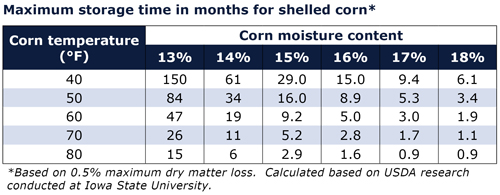
Managing drought-damaged corn
 By Jon Feitz
By Jon Feitz
The ongoing drought has raised concerns about the potential quality of this year’s corn crop. A heat-stressed corn crop carries a higher potential for damaged corn kernels. This, coupled with high moisture content and high temperatures at harvest time, can lead to a higher incidence of molds and the mycotoxins they can produce. Ultimately, this results in negative impacts on livestock performance. However, proactive planning in regard to harvest management, handling, and storage of corn this fall can help maximize storage life and feed value. Grain experts suggest moving quickly at harvest, as molds can increase up to 6 percent per hour on trucks or in bins prior to drying. So, getting grain from the field to the drier as fast as possible can improve quality. Many references suggest drying corn to 15 percent moisture content prior to storage, but keep in mind pockets of corn can be 2 to 3 percent higher than the average of the lot. General rules of thumb are to dry corn to 15 percent moisture if the crop is to be stored through the spring, 14 percent if stored through summer, and 13 percent if stored for more than a year. However, this year you may need to dry to 0.5 to 1 percent drier to compensate for increased kernel damage. The following table shows the effects of temperature and moisture content on the allowable storage time of shelled corn.
Effects of temperature and moisture content on allowable corn storage time
Aeration is also important to maintaining the quality of stored corn. Steps should be taken to decrease the amount of fines that make it into bins, as they hinder bin aeration and lead to lower grain quality. Installing high capacity screen cleaners in the grain handling system and “coring the bin” (unloading one or more loads from the bin after filling) are two approaches to improving aeration, as fines tend to accumulate near the center of the bin. Weekly monitoring of stored corn is highly recommended. Establish a regular monitoring routine that enables timely reaction if bins start to go bad. Others suggest spreading out grain equally among bins as an insurance factor, as half-full bins can be dried and aerated twice as fast as full bins.
Source: Gary Woodruff, GSI; Matt Roberts, Grain Quality Extension Specialist & Richard Stroshine, Professor Agriculture and Biological Engineering Dept. Purdue University; University of Minnesota Extension, publication WW01327
About the author: Jon Feitz previously worked with Vita Plus as a swine account manager. He received his education from Purdue University with a major in agricultural business. He has experience with both swine genetics and nutrition. Feitz lives in Indiana with his four children.
| Category: |
Corn and soybeans Drought Feed costs Swine Performance |


